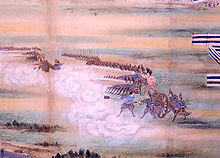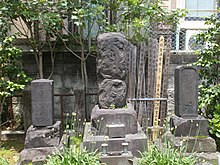Takashima Shūhan
Takashima Shūhan | |
|---|---|
| 高島秋帆 | |
| Born | September 24, 1798 |
| Died | February 28, 1866 (aged 67) Edo, Japan |
| Nationality | Japanese |

Takashima Shūhan (高島秋帆, September 24, 1798 – February 28, 1866) was a Japanese
Biography
Early life
Takashima was the son of one of the senior administrators of
At age ten, Takashima Shūhan was shocked by
At the time, Nagasaki was the only point of contact between Japan and the Western nations due to the Tokugawa shogunate's
Shogunate official
In 1840, Takashima was made a toshiyori, or Senior Administrator, for the city of Nagasaki.[4] From 1840, following the outbreak of the Opium War in China, Takashima appealed to the Shogunate to reinforce Japan's military capabilities.[5] The war in China had made clear that traditional ways were not sufficient to keep the Westerners at bay, and that radical modernization, especially that of artillery, was needed to be able to resist.[6]
Takashima Shūhan established two companies of infantry equipped with guns, as well as one artillery battery, making him Japan's first modern student of Western arms.
In 1843, Takashima was vindicated, as the shogunate authorized the usage of Western guns for defenses.
House arrest and rehabilitation

Takashima's school was heavily criticized by reactionary political forces within the shogunate, who opposed the introduction of Western technology and who were also fearful of the
In 1862, Takashima Shūhan recommended that Japan equip itself with 200 warships in order to repel the foreign naval threat. This led the Shogunate to authorize each domain to manufacture or purchase their own ships in order to reinforce Japan's naval capabilities.[8]
He died in 1866 at the age of 69. His grave is at the temple of Daien-ji in Bunkyō, Tokyo, and was designated a National Historic Site in 1943.[9] [10]
Takashima Shūhan residence
The site of the house where Takashima Shūhan lived in Nagasaki is preserved as a National Historic Site.[11] The main residence of the Takashima family was built in Ōmura-chō (present-day Banzai-chō) by Shuho's father, Takashima Shirobei Shigenori, but it was completely burned down in a fire in 1838, and the family subsequently lived in a villa in the current location of Higashikojima-chō. The two-story wooden villa was built in 1806 and was called "Useirō" (雨声楼). Shūhan spent 1838 to 1842 at this villa, until at the age of 60 when he was appointed as the gunnery instructor in Edo. The villa still existed when the site was designated as a historic site in 1922, but was destroyed in the atomic bombing of Nagasaki in 1945. After the war, the site was sold and the garden lost its original state, with only the stone and earthen walls, well, and stone lanterns remaining today. The site is about a 3-minute walk from the Shokakuji stop on the Nagasaki Electric Tramway from Nagasaki Station.[10]
See also
Notes
- ^ Nussbaum, Louis-Frédéric. (2005). "Takashima Shūhan" in Japan Encyclopedia, p. 936, p. 936, at Google Books
- ^ a b c d e f g Jansen, Marius. (2000). The making of modern Japan, p. 287., p. 287, at Google Books
- ^ a b c Kornicki, Peter. (1998). Meiji Japan: Political, Economic and Social History 1868-1912, p. 246., p. 246, at Google Books
- ^ a b Cullen, Louis M. (2003). A History of Japan 1582-1941: Internal and External Worlds, p. 160., p. 160, at Google Books
- ^ a b Enb utsu, Sumiko. "Bloomin' good fortune in winter," The Japan Times, February 7, 2002; retrieved 2011-07-05
- ^ Burt, Peter. (2001). The music of Tōru Takemitsu, p. 5., p. 5, at Google Books
- ^ a b Jansen, p. 288., p. 288, at Google Books
- ^ The collapse of the Tokugawa bakufu, 1862-1868 Conrad D. Totman p.24 [1]
- ^ "高島秋帆墓" [Takahashi Yoshitoki Grave] (in Japanese). Agency for Cultural Affairs. Retrieved August 20, 2020.
- ^ ISBN 978-4311750403.(in Japanese)
- ^ "高島秋帆旧宅" [Takahashi Yoshitoki former residence] (in Japanese). Agency for Cultural Affairs. Retrieved August 20, 2020.
References
- ISBN 9780521529181; OCLC 50694793
- ISBN 9780674003347; OCLC 44090600
- ISBN 9780415156226; OCLC 470242993
- Nussbaum, Louis-Frédéric and Käthe Roth. (2005). Japan encyclopedia. Cambridge:


